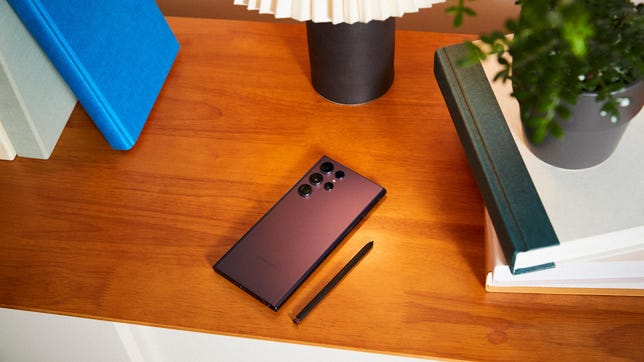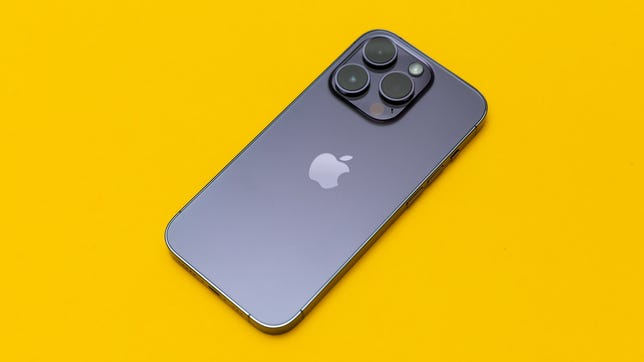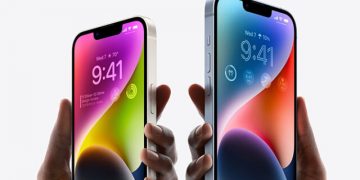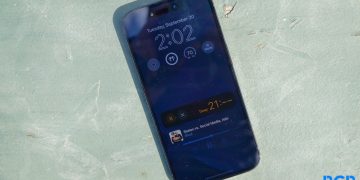This story is part of Focal Point iPhone 2022, CNET’s collection of news, tips and advice around Apple’s most popular product.
Apple’s iPhone 14 Pro and Samsung’s Galaxy S22 Ultra have some stark differences in their features, but there’s one thing they have in common: Both companies champion these high-grade phones as having sophisticated, impressive cameras.
One of the biggest ways the iPhone 14 Pro differs from last year’s 13 Pro, for example, is in its new camera system. Apple’s new premium iPhone has a high-resolution 48-megapixel main sensor and other improvements like the Photonic Engine, which is a new technique that applies Apple’s Deep Fusion processing to images earlier for better detail. When Samsung unveiled the Galaxy S22 Ultra in February, it similarly highlighted the 108-megapixel main camera as a major area of focus — particularly the S22 Ultra’s improved low-light photography.
In practice, both phones take impressive photos that are rich with color and detail. As for which one is better, the answer is somewhat subjective and may come down to whether you prefer the way Apple or Samsung processes photos. But in my experience, Apple’s iPhone 14 Pro generally does a better job of producing well-balanced images, while Samsung has a much closer zoom that can’t be matched.
To test the cameras on both phones, I took the same images side-by-side under various lighting scenarios, ranging from bright outdoor sunlight to dim indoor environments with very little or no light.
iPhone 14 Pro and Galaxy S22 Ultra Camera Specs
iPhone 14 Pro
Galaxy S22 Ultra
Number of cameras (rear)
3
4
Main camera resolution
48-megapixel
108-megapixel
Ultrawide camera resolution
12-megapixel
12-megapixel
Ultrawide field-of-view
120 degrees
120 degrees
Zoom camera resolution
12-megapixel
10-megapixel (2 lenses)
Zoom
3x optical zoom in, 15x digital zoom
3x or 10x optical zoom, 100x digital zoom
Aperture
f1.78 (main), f2.2 (ultrawide), f1.78 (zoom)
f1.8 (main), f2.2 (ultrawide), f4.9 (zoom), f2.4 (zoom)
Night mode
Yes
Yes
Special features
Photographic styles, macro photography, portrait mode with portrait lighting, Apple ProRaw
Directors view, single take, portrait mode, expert raw (separate app)
Video recording
4K at up to 60 fps, action mode, cinematic mode
8K at 24 fps, 4K at up to 60 fps, super steady stabilization
Other details
Photonic engine applies deep fusion earlier in the process for better detail, second-gen sensor shift for image stabilization, new quad pixel sensor that combines every 4 pixels into 1 big 2.44um pixel. Option to use 2x zoom that uses the middle 12 megapixels for full resolution with no digital zoom (good for portrait mode.) Full 48MP photos in Pro Raw
Adaptive pixel combines pixel binning (which blends data from multiple pixels into one giant pixel) with resolution from the main sensor. Laser autofocus sensor for improving focus in close range and low light environments, optical image stabilization
iPhone 14 Pro vs. Galaxy S22 Ultra: Bright outdoor sunlight
If you’re shooting photos in outdoor sunlight, you can rest assured that both the iPhone 14 Pro and Galaxy S22 Ultra are capable of capturing excellent photos. In the photo samples below, you’ll notice the photos of the ice cream truck and sidewalk murals are both colorful and well-lit. The biggest difference can be seen in the photos of ducks on the beach. Samsung’s photo is brighter and makes the colors of the river and sand pop more. But Apple’s has more detail and contrast in the pebbles and glass shards on the shore.
iPhone 14 Pro vs. Galaxy S22 Ultra: Zoom
The iPhone 14 Pro can zoom up to three times optically and 15 times digitally, while the Galaxy S22 Ultra has an optical zoom of 3x or 10x and can also zoom digitally up to 100 times. I used the maximum zoom level on each phone to get a sense of how much their range differs, as you can see in the photos of the highway sign below.
There’s no question that Samsung can achieve a significantly closer zoom than Apple, although it’s not very sharp and it’s very hard to focus when zooming in at 100x. Using the Galaxy S22 Ultra’s 100x zoom doesn’t seem very practical unless you really need to see something that’s very far away and don’t necessarily care about image quality.
iPhone 14 Pro 15x digital zoom/Galaxy S22 Ultra 100x digital zoom
Here’s how they perform at a much more realistic 10x zoom. Both are very clear, but the text on the sign is brighter and bolder in the iPhone 14 Pro’s image.
iPhone 14 Pro vs. Galaxy S22 Ultra: Portraits
When it comes to Portrait Mode photos that slightly blur the background to make the subject stand out more, the iPhone 14 Pro performed better in dim outdoor lighting. In the photos taken at an outdoor wine bar below, the iPhone 14 Pro’s image is more accurate in terms of eye and skin color, and there’s generally more detail in the face. Samsung seems to have struggled with the lightning for this shot, although the color of the subject’s beard does look more accurate.
Portrait Mode
In the same photo without Portrait Mode turned on, I preferred Samsung’s photo. The Galaxy S22 Ultra generally captured more detail.
Portrait (regular, no Portrait Mode)
iPhone 14 Pro vs. Galaxy S22 Ultra: Night mode
Both phones are capable of taking relatively bright photos in low-light circumstances, as shown in the photos below of my cat that was taken in night mode with most of the lights in my apartment turned off. But Samsung’s photo is much more detailed, even though the iPhone’s picture is a bit brighter. The iPhone 14 Pro’s photo is softer and lacks the detail and clarity in the cat’s fur that you get in the Galaxy S22 Ultra’s image.
iPhone 14 Pro vs. Galaxy S22 Ultra: Macro
When it comes to close-up macro shots, the iPhone 14 Pro and Galaxy S22 Ultra each produced colorful, sharp photos. I slightly preferred the iPhone 14 Pro’s because I thought it had a little more depth to it. But it’s also a bit washed out compared to Samsung’s photo, so it’s a tough call.
iPhone 14 Pro vs. Galaxy S22 Ultra: Ultrawide
The iPhone 14 Pro and Galaxy S22 Ultra each have a 12-megapixel ultrawide camera with a 120-degree field-of-view. Both cameras captured crisp detail and color when photographing a sidewalk mural, as shown below.
But the iPhone 14 Pro did a better job of capturing this tree-lined scene at a local park. The iPhone 14 Pro’s photo feels more balanced, and there’s a good amount of contrast between the bridge, sky and trees. Samsung’s photo, on the other hand, looks a bit washed out in the right corner where the bridge is located. However, this is the only photo where this type of lens flare was very noticeable.
iPhone 14 Pro vs. Galaxy S22 Ultra: Raw photos
You can shoot Raw images on both phones, but the process of doing so is a bit different on each device. On the iPhone, you can choose to shoot with Apple’s ProRaw setting, which combines the customization of a raw file with some elements of Apple’s computational photography. The result is a photo that still has a lot more image data than the standard image you’d normally capture on an iPhone, but with some of Apple’s photo-processing smarts.
Samsung, meanwhile, offers an app called Expert Raw that you can download separately to take raw photos on your Galaxy phone. It saves the image in both raw and JPEG formats and also includes controls for adjusting elements like the ISO, shutter speed and white balance. You can also jump straight to Adobe Lightroom right from the Expert Raw app, which is handy for editing on the go.
I shot the same scene below using Apple’s ProRaw setting on the iPhone 14 Pro and Samsung’s Expert Raw app on the S22 Ultra. Then, I edited each one in Adobe Lightroom and exported them to the JPEG file format so that they’re easily viewable in this story. Even though they’ve been compressed, you can still get a good sense of how each phone generally captures elements like color, detail, texture and lighting.
In the Galaxy S22 Ultra’s photo, I turned down the highlights, boosted the shadows and made some other minor adjustments. For the iPhone 14 Pro’s image, I bumped up the exposure, contrast and shadows.
iPhone 14 Pro vs. Galaxy S22 Ultra: The bottom line
Both the iPhone 14 Pro and Galaxy S22 Ultra are capable of taking sharp, colorful photos. But they succeed in different areas, and which one is best for you will depend on your priorities and shooting style. Each phone excelled at taking photos in ideal lighting outdoors. I preferred the iPhone 14 Pro’s camera when shooting ultrawide landscape shots and Portrait Mode photos. The Samsung, on the other hand, is capable of a much closer zoom than the iPhone, and I also thought the Galaxy S22 Ultra captured better photos in challenging lighting conditions, both indoors and outside.
Stephen Shankland/CNET
Apple’s iPhone 14 Pro and Pro Max introduce sweeping changes like the Dynamic Island, a new 48-megapixel camera system and Apple’s new A16 Bionic processor. All of these upgrades come together to make for an experience that feels fresh and fast compared to older generations.
Read our Apple iPhone 14 Pro review.

Samsung
Samsung’s latest flagship superphone, the Galaxy S22 Ultra has an impressive lineup of specs, including a quadruple rear camera, a big, vibrant display and the S Pen stylus you might remember from the Galaxy Note series. It comes with a high price, but those of you looking for one of the best Android phones around should have this on your short list.
Read our Samsung Galaxy S22 Ultra review.
You’re receiving price alerts for Samsung Galaxy S22 Ultra (128GB, Phantom Black)
Source by www.cnet.com





























